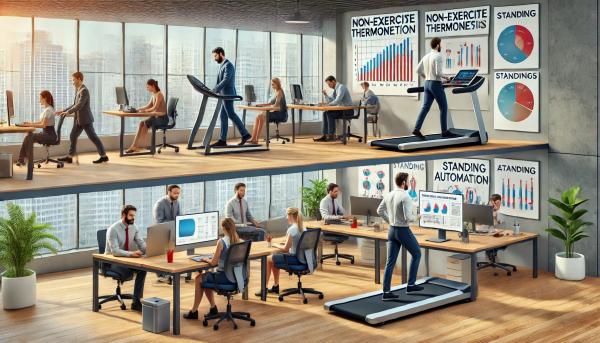
“Sitting is more dangerous than smoking, kills more people than HIV and is more treacherous than parachuting. We are sitting ourselves to death.”
-Dr. James Levine, co-director of the Mayo Clinic and the Arizona State University Obesity Initiative
These are pretty strong words, and although there is a bit of hyperbole, Dr. Levine was getting at a concept he called NEAT – “the energy expended for everything we do that is not sleeping, eating or sports-like exercise.” Two-thirds of our energy expenditure can be found in NEAT, and for a country with a growing weight problem, increasing the energy expending on those non-exercise activities might be beneficial. But as Dr. Levine goes on to explain:
“Physical activity may be part of normal daily activities as a natural by-product of other activities and at no additional cost, such as physical work, walking to get to places and doing house chores, but familiar technologies have diminished substantially these activities.”
For many of us, the most significant part of our day outside sleeping and eating is at work. But as Dr. Levine cautioned:
“The 1930s saw the rise of the archenemy—the office chair. Workplace automation and mechanization followed with the introduction of typewriters, Dictaphones, intercoms, and adding machines—all of which diminished movement. …It took nature 2 million years to design the walking, dynamic human, and it took those humans 200 years to reverse the art of nature and cram people all day long into chairs.”
So ever the entrepreneur, Dr. Levine found a workplace solution, the treadmill desk, a mashup of a standing desk with a treadmill where you could multitask and work and exercise simultaneously. In a subsequent year-long study, individuals with a treadmill desk utilized 74 additional calories daily compared to controls sitting at their desks. (In terms of weight loss, this is about one-third of an ounce). This was reflected in a shift from sedentary to light or active activities. While work productivity faltered during the first six months, presumably due to learning how to multitask the two activities, productivity, as measured by both worker and supervisor, had recovered and improved slightly by year's end.
While concluding that a treadmill desk “has a significantly favorable impact on both physical activity and work performance,” the research pointed out that a treadmill desk costs $4,000, making it an expensive purchase.
There are, of course, other ways to reduce sedentary activity and get out of our chairs. Standing desks are among the more uncomplicated alterations to the office environment, which come at a lower cost. A new study looked at stand-capable workstations. Before jumping in, let me mention that the two primary reasons for a need for increased caloric expenditure being more active were the “health risks associated with a low-activity lifestyle” and that sitting while working (SWW) “work is associated with increased musculoskeletal pain and discomfort, especially in the shoulders, neck, and lower back.”
The researchers looked at height-adjustable workstations, sit-stand workstations, fixed stand-based workstations, and traditional desks. Their outcome measures physical activity, work productivity (as measured by computer use), and discomfort. Sixty-one volunteers were identified working in administrative roles in a university office, categorized by having a traditional desk and acting as the controls or having a form of stand-capable workstations.
Like Dr. Levine’s treadmill desk study, activity was measured by ergometers, which are more sophisticated forms of measuring activity than your Apple watch.
- Productivity – There was no significant difference in the number of key clicks or word error rates between the three groups, although the stand-biased group typed more words.
- Energy Expenditure – As would be anticipated, those with traditional desks sat more than those with standing desks. Those with traditional and height-adjustable desks changed position more often than those with fixed-height desks; again, no surprise. There were no differences in energy expenditure, step count, or step time per day between the groups based on complete 24-hour activity data.
- Discomfort – as measured by self-reporting, 65% of all participants reported neck discomfort, presumably from staring at those computer screens. The only difference was that 80% of those using traditional desks (and chairs) reported lower back discomfort.
Much like the optimistic Dr. Levine, these researchers concluded:
“Desks which encourage standing can lead to benefits, but further research is needed to examine any potential link.”
What might we conclude?
Dr. Levine’s hyperbolic assessment of sitting does point to the old principle of physics that a body at rest tends to remain at rest, while a body in motion tends to stay in motion. Neither study convincingly demonstrates that a change in furniture will bring about a significant change in activity. There is a lot to be said in favor of getting up every hour or so from your desk to take a walk, more to clear your head, but with the added benefits of using those God-given limbs. Just as we are not going to eat our way to health, we are not going to stand or sit our way there either. Incorporating more movement into your day is simple but requires a commitment to moving more, and the commitment rather than the activity is the greatest hurdle.



